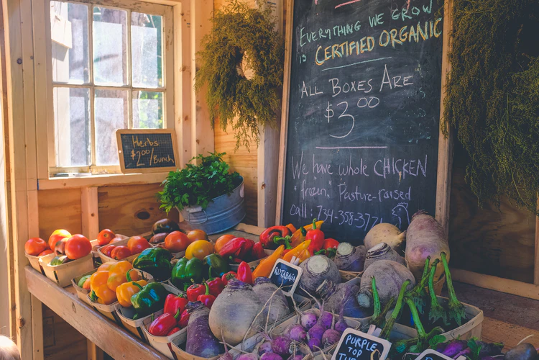
Photo by Ella Olsson from Pexels
By Abigail Mathew, Intern at the Alliance for Sustainability (www.afors.org)
Look for Seasonal Produce
Looking for seasonal produce offers similar green benefits to regional products. Local produce grown in season will require even less transportation than normal to make it to your grocery store. If you consider which crops are in season, you get fresher and better-tasting produce and they may have fewer preservatives to keep them fresh on their journey. As soon as produce leaves the vine or tree, fruits and vegetables start to lose their nutritional value. Some produce—such as spinach and broccoli—begin to lose nutrients within hours of picking. Green beans, for example, will lose 77% of their vitamin C after a week of storage, according to the Department of Food Science and Technology at the University of California, Davis.

1.3 billion tons of food is being wasted every year. Unfortunately, some of this waste is not self-evident to consumers because some of it happens along the supply chain.
Source: Center for Health Law and Policy Innovation
Opt for the Ugly Produce
Another piece of advice is to opt for the “ugly” produce. Retailers as well as consumers want their food to look a certain way, but the prioritization of aesthetically pleasing produce has led to a lot of food waste. Food loss often occurs even before a consumer would even see it as farms discard goods along the supply chain, especially during harvesting and processing.
Consumers like us, restaurants, and retailers also contribute to food waste rejecting the “ugly produce”, which includes fruits and vegetables with scarring or bruising. The USDA estimates that a third of all produce from farmers goes uneaten, amounting to about $161.6 billion in waste. Some of this waste has to do with logistical issues, but much of it is wasted due to cosmetic reasons.
It is important to realize that these bruises or strange shapes don’t make an impact on the food’s taste or nutritional value as long as there aren’t any signs of disease. A bruise can often just be cut out if it hasn’t affected the rest of the produce. Sometimes you might be able to get it for free or a discount because the produce manager knows it will likely be composted otherwise. If you’re buying fruit that you plan to eat the same day, try the ones already showing signs of ripeness so they don’t end up being discarded. And remember, the outside appearance of produce doesn’t matter as much when it is cut up or prepared.
A study titled Estimating Quantities and Types of Food Waste at the City Level found that an average of 3.5 pounds of food per person was wasted at home every week. The most common reason given for wasting edible food was that the food was moldy or spoiled. By planning your shopping trip to your eating habits, you can save a lot of food waste. And choosing “ugly” foods instead of ideal ones can prevent good produce from being wasted.

Source: Unsplash
Buy Organic
Purchasing certified organic food can make a huge difference in moving towards sustainability because organic farming builds healthy soil while protecting farmers, farmworkers, consumers, wildlife, and the environment from hazardous chemicals. Non-organic foods are often grown with toxic pesticides and synthetic fertilizers that harm beneficial organisms, pollute the environment, decrease plant nutrient uptake and cause secondary pest outbreaks. Some of these chemicals kill pollinators, spiders, and soil microorganisms that plants rely on to fruit, minimize pests and grow in nutrient-rich soil. This creates a “chemical treadmill” in which more and more chemicals are needed.
Your purchase of organic food helps protect you and the surrounding ecosystem. It keeps toxins out of the air, drinking water, and soil, as well as our rivers, lakes, and oceans. While organic food usually costs more, if we had to pay all of the hidden costs of conventional, it would appear to be cheap. Buying organic is worth it in terms of your health and that of future generations. Voting organic with your food dollars creates the incentive for farmers to transition to organic, and ultimately, to save huge amounts of money in terms of our health care and the clean-up of the water and the environment.
Next: Buying Bulk Goods and Reducing Meat Consumption
